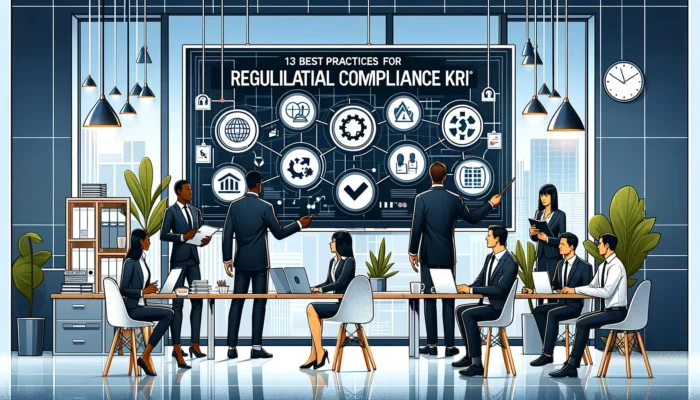An example of a Key Risk Indicator (KRI) could be the number of system outages experienced by an IT department over a certain period.
This KRI could be used to assess the risk of future outages, which could lead to business interruptions and impact the organization’s operations.
If the number of outages increases beyond a predefined threshold, it might signal a higher risk of operational issues, prompting the need for preventive measures such as system upgrades or more robust backup solutions.
Another example is the employee turnover rate within an organization. A high turnover rate might indicate underlying issues such as employee dissatisfaction, poor work environment, or inadequate compensation, which could pose a risk to the organization’s stability and performance.
Another example of a Key Risk Indicator (KRI) is the credit default swap (CDS) spread for a financial institution. The CDS spread reflects the cost of insuring a company’s debt against default.
A widening CDS spread can indicate that the market perceives an increased risk of default, which could signal financial distress for the institution.
Financial analysts and risk managers would monitor this KRI closely, as it can provide early warnings about the financial health of the company (Investopedia).
Last example is the loan-to-value (LTV) ratio for a portfolio of loans held by a bank. The LTV ratio measures the value of loans against the value of the collateral securing them.
An increasing LTV ratio could indicate that the bank’s loan portfolio is becoming riskier, potentially leading to higher default rates if the value of the collateral declines (Corporate Finance Institute). Monitoring the LTV ratio as a KRI can help a bank manage its credit risk exposure.
Monitoring this KRI can help an organization address these issues proactively to maintain a stable and productive workforce.
The concept of a kri may seem elusive to some, yet its significance cannot be overstated. Defined as a unique phenomenon that challenges conventional thinking, a kri possesses distinct characteristics that set it apart.
But what exactly is an example of a kri? In order to understand this, we must first delve into the nature of kris and their implications.

By exploring the importance of identifying and comprehending kris, we will eventually uncover a real-life example that will shed light on this intriguing concept. Stay tuned for an enlightening journey into the world of kris and their profound impact.
Key Takeaways
- KRIs are specific metrics that provide early warning signs of potential risks.
- Effective KRIs align with business objectives and help understand an organization’s risk profile.
- Common examples of KRIs include customer satisfaction metrics and financial performance indicators.
- KRIs support decision-making processes by monitoring the risk landscape and ensuring regulatory compliance.
Definition of a Kri
In the field of risk management, Key Risk Indicators (KRIs) play a crucial role in identifying and monitoring potential risks that may impact an organization.
KRIs are specific metrics or data points that provide early warning signs of potential risks, allowing companies to take proactive measures to mitigate them.
Importance of KRIs in risk management
KRIs, or Key Risk Indicators, play a crucial role in effective risk management by providing early warning signals for potential risks and helping organizations take proactive measures to mitigate them.
The importance of KRIs in risk management can be seen in their ability to align performance metrics with strategic goals, facilitate risk assessment and identification, quantify risk exposure, and enable the development of action plans for risk mitigation.
KRIs are a valuable tool for organizations to stay ahead of potential risks and protect their interests.
Characteristics of a Kri
When discussing the characteristics of a Kri, it is important to consider several key attributes.
These attributes include:
- The ability to identify effective Kri,
- The relevance of Kri to business objectives and strategies, and
- The quantifiability and measurability of Kri.
Key Kri Attributes
Key attributes of a KRI encompass a range of essential characteristics that define its significance and effectiveness in risk management. These attributes include:
- Performance: KRI measures the performance of processes and actions taken to manage potential risks.
- Key performance indicators: KRI utilizes specific indicators to assess the effectiveness of risk management efforts.
- Risk profile: KRI helps in understanding the organization’s risk profile and identifying areas of concern.
- Implementation: KRI provides a framework for the implementation of risk mitigation strategies and actions.
These attributes ensure that KRI effectively monitors and manages various types of risks, providing timely warnings and aligning risk appetite with organizational objectives.
Common Kri Examples
In order to effectively manage and monitor potential risks, it is crucial to understand the common characteristics of Key Risk Indicators (KRIs). KRIs provide businesses with valuable insights into key risks and risk trends, allowing them to make informed decisions.
Common KRI examples include customer satisfaction metrics, which help businesses identify operational risks and improve customer experience. By incorporating risk identification methods and involving the risk management team, businesses can adopt a proactive risk management approach to mitigate potential threats.
Identifying Effective Kri
To effectively identify effective KRIs, it is essential to understand the key characteristics that make a KRI valuable in risk management. Here are some important characteristics of effective KRIs:
- Alignment with business objectives and strategies
- Relevance to specific industries and risk categories
- Ability to measure and monitor risk factors
- Clear and concise presentation of risk posture, events, responses, and impact indicators
Relevance to business objectives and strategies
Relevance to business objectives and strategies is a crucial characteristic of an effective Key Risk Indicator (KRI) in risk management.
KRIs are instrumental in strategic planning, as they provide valuable insights into potential risks that may hinder the achievement of business objectives.
By incorporating KRIs into risk analysis, businesses can identify and prioritize risks, allowing for effective risk mitigation and prevention strategies.
KRIs also aid in risk estimation and help align risk management efforts with overall business frameworks and the enterprise risk management strategy.
| Strategic Planning | Risk Management | Business Objectives |
|---|---|---|
| Aligns risk management efforts with strategic goals | Identifies and prioritizes risks | Helps achieve business objectives by mitigating and preventing risks |
Quantifiability and measurability
Quantifiability and measurability are essential characteristics of a Key Risk Indicator (KRI) in effective risk management. When it comes to managing risks, having quantifiable and measurable KRIs is crucial.
These characteristics allow for accurate risk assessment, measurement, and analysis.
Here are some key points to understand about quantifiability and measurability in KRIs:
- Quantifiable KRIs provide numeric values that can be tracked and analyzed.
- Measurable KRIs allow for the comparison of data over time and the identification of trends.
- Key risk indicators with quantifiable and measurable metrics enable effective risk monitoring and tracking.
- These characteristics enhance the precision and reliability of risk management processes.
Timeliness and frequency of data collection
The timeliness and frequency of data collection are critical factors in determining the effectiveness of a Key Risk Indicator (KRI). Timeliness refers to how quickly the data is collected and made available for analysis, while frequency refers to how often data is collected.
These factors are crucial in risk management as they enable timely risk estimation, analysis, and mitigation. For example, in credit risk exposure, timely and frequent data collection allows for proactive risk prevention and management strategies.

Ability to provide actionable insights
An essential characteristic of a Key Risk Indicator (KRI) is its ability to provide actionable insights for effective risk management. This means that KRIs should offer practical information that can be used to inform decision-making and drive risk mitigation efforts.
Some ways in which KRIs can provide actionable insights include:
- Identifying potential risks and vulnerabilities through risk analysis.
- Informing the development of risk prevention initiatives and strategies.
- Assisting in the estimation and measurement of risks over time.
- Supporting the monitoring and evaluation of risk mitigation indicators.
Importance of Understanding Kri
Understanding Kri is crucial for effective risk management. It allows organizations to monitor and measure risks, enabling them to identify and address potential issues before they escalate.
Additionally, a deep understanding of Kri supports informed decision-making processes, empowering organizations to make strategic choices based on reliable data and insights.
Monitoring and measuring risks
Effective risk management relies on comprehensive monitoring and measurement of potential risks, highlighting the importance of understanding Key Risk Indicators (KRIs).
To effectively monitor and measure risks, the following practices should be implemented:
- Regular reviews of KRIs over a specific period of time
- Identification and evaluation of warning signs and trends over time
- Assessing the level of risk and potential impact on the organization
- Implementing controls and taking corrective action to mitigate the financial impact of risks.
Early detection of potential issues
To ensure timely identification of potential issues, a thorough understanding of Key Risk Indicators (KRIs) is essential in effective risk management.
Early detection of these indicators allows for proactive risk analysis and mitigation, enabling organizations to make informed strategic decisions.
KRIs serve as warning signals, highlighting potential risks and their impact on business operations.
Supporting decision-making processes
A comprehensive understanding of Key Risk Indicators (KRIs) is crucial for supporting effective decision-making processes in risk management. To achieve this, organizations must consider the following:
- Align KRIs with strategic goals and key goals outlined in the strategic plan.
- Continuously monitor the risk landscape to identify emerging risks.
- Utilize software tools to collect and analyze KRI data efficiently.
- Ensure compliance with regulatory requirements while managing financial risks, market risks, and operational risk management.
Example of a Kri in Real Life
The financial industry provides a prominent example of a KRI in real life. With the increasing complexity and interconnectedness of the global financial system, identifying and managing key risk indicators is crucial for ensuring stability and mitigating potential crises.
Financial Industry:
Exemplifying the potential impact of Kri technology in the financial industry, a recent case study unveils an innovative approach to streamlining transaction processes and enhancing security measures. This technology has the ability to address several key challenges faced by financial institutions.
These include:
- Improving financial metrics and industry benchmarks.
- Reducing compliance risks and cyber risk exposure.
- Managing employee turnover rate and customer complaints.
- Ensuring regulatory compliance.
- Adapting to changing economic conditions.
- Mitigating competitive risk.
- Supporting strategic initiatives.
How to Identify a Kri
One effective method for identifying a KRI is by examining its unique physical characteristics and behavioral traits. By understanding the difference between critical metrics and business goals, organizations can identify potential KRI.
Process inefficiencies, malfunctioning functions, or control environments can all contribute to the negative impact on organizational goals. Additionally, weak internal controls and vulnerabilities to cyber risk should also be considered when identifying potential KRI.

Frequently Asked Questions
Can You Provide a Step-By-Step Guide on How to Perform a Kri?
Performing a Kri involves a step-by-step process that may vary depending on the specific Kri being practiced. It typically includes physical postures, breath control, and meditation techniques aimed at achieving specific physical, mental, or spiritual benefits.
Are There Any Health Risks Associated With Practicing Kri?
There are potential health risks associated with practicing Kri, such as physical strain, overexertion, and the possibility of exacerbating existing medical conditions. It is important to consult with a healthcare professional before starting any new exercise regimen.
What Are Some Common Misconceptions About Kri?
Some common misconceptions about kri include the belief that it is a religious practice, that it requires extreme flexibility or physical fitness, and that it is only suitable for certain age groups or lifestyles.
Can Kri Be Combined With Other Spiritual Practices or Exercises?
Kri can indeed be combined with other spiritual practices or exercises, as it is a versatile and adaptable practice. By integrating Kri with other techniques, one can enhance their spiritual growth and holistic well-being.
Are There Any Specific Age or Physical Requirements to Practice Kri?
There are no specific age or physical requirements to practice Kri. It is a spiritual practice that can be adapted to individual abilities and needs, making it accessible to people of all ages and physical conditions.

Conclusion
In conclusion, a kri is a term used to describe a situation or event that is unexpected or unpredictable. It is characterized by its unique and unrepeatable nature.
Understanding kris is important as it helps individuals navigate through uncertainties and make informed decisions. An example of a kri in real life could be winning the lottery or encountering a life-changing opportunity unexpectedly.
By identifying kris, individuals can be better prepared to adapt and respond effectively.

Chris Ekai is a Risk Management expert with over 10 years of experience in the field. He has a Master’s(MSc) degree in Risk Management from University of Portsmouth and is a CPA and Finance professional. He currently works as a Content Manager at Risk Publishing, writing about Enterprise Risk Management, Business Continuity Management and Project Management.

